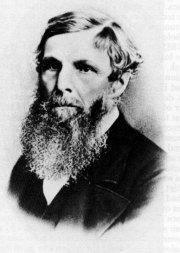William Froude facts for kids
Quick facts for kids
William Froude
|
|
|---|---|

William Froude
|
|
| Born | 28 November 1810 |
| Died | 4 May 1879 (aged 68) Simonstown, South Africa
|
| Nationality | English |
| Education | Westminster School |
| Occupation | Engineer |
| Engineering career | |
| Significant advance | Hydrodynamics, Froude number |
| Awards | Royal Medal (1876) |
William Froude was an important English engineer. He studied how water moves and how ships float. He was born in Devon, England, on November 28, 1810. He passed away in Simonstown, South Africa, on May 4, 1879. Froude was the first to create reliable rules for how much water pushes against ships. He also helped predict how stable ships would be in the water.
Contents
Early Life and Education
William Froude was born in Dartington, Devon, England. His father was Robert Froude, who was a church leader. William went to Westminster School and then to Oriel College, Oxford. He studied mathematics and finished with top honors in 1832.
Working on Railways
Froude's first job was as a surveyor for the South Eastern Railway. In 1837, a famous engineer named Isambard Kingdom Brunel gave him a big job. Froude was put in charge of building part of the Bristol and Exeter Railway.
While working on the railway, Froude created a new way to design railway curves. He also designed a different kind of bridge called a "skew arch" bridge. These bridges were built near Exeter. During this time, he lived in Cullompton and helped with the local church. He even paid a lot of money to help rebuild parts of the church. He left Cullompton in 1844 when the railway line was finished.
Understanding Ship Movement

Brunel asked Froude to study how ships stay stable in rough seas. In 1861, Froude wrote an important paper about ship design. This led to a special task: finding the best shape for a ship's hull.
Froude discovered that he could use small models to test ship designs. He created a formula, now called the Froude number. This formula allowed him to use results from small-scale tests to predict how full-sized ships would behave. He built models that were 3, 6, and 12 feet long. He pulled these models through water to see how much resistance they had.
The British Navy, called the Admiralty, tested Froude's ideas with real ships. His experiments worked perfectly! Because of this, the first special tank for testing ship models was built. It was built at Froude's home in Torquay, paid for by the public. Here, he combined his math skills with hands-on experiments. His methods are still used by ship designers today.
Froude also tested a theory about ship shapes by John Scott Russell. He compared two models: Raven and Swan. Raven had a sharp design, while Swan had a fuller, blunter shape. Raven had less resistance at slow speeds. But Swan had less resistance at higher speeds. This showed that Scott Russell's theory was not always correct. It helped engineers better understand how ship hulls move through water.
Inventing the Water Brake
In 1877, the Admiralty asked Froude to create a machine. This machine needed to measure the power of large ship engines. Froude invented the world's first water brake dynamometer. This machine uses water to absorb and measure power. His invention led to the creation of a company called Heenan & Froude Ltd.
Later Life and Legacy
William Froude died on May 4, 1879, while on holiday in Simonstown, South Africa. He was a guest of the Royal Navy and was buried there with full naval honors.
He had two brothers who were also famous: James Anthony Froude, a historian, and Hurrell Froude, a writer and priest. William was married to Catherine Henrietta Elizabeth Holdsworth. Her father was a governor and a member of Parliament.
See also
 In Spanish: William Froude para niños
In Spanish: William Froude para niños
- Antiroll tanks
- Blade element theory
- Froude's law of similitude
- Froude number
- Froude efficiency
- Froude's experiments
- Froude–Krylov force
- Propeller theory
- Track transition curve
- Water brake-type absorber


